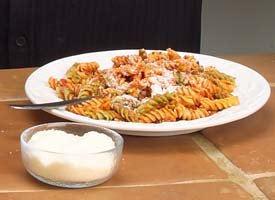Earlier on it was fat that was the big evil. Every day there were new low-fat products coming out on the market. Some were lower fat versions of the same food and others were low-fat substitutes that were meant to replace other higher fat options. Everywhere you turned, fat was avoided.
In this decade however sugar has become the new evil, and more and more individuals are starting to remove it from their diets. There are a variety of sugar substitute products out on the market that you can now use to replace sugar in many of your recipes and a variety of pre-made foods that you purchase in the grocery store are now using Splenda or some variation to replace traditional sugar or corn syrup.
With this move towards a heightened awareness of the problems with sugar and your health, out came the 'Sugar Busters' Diet.
The Sugar Busters Diet
Started by H. Leighton Steward, who holds a Masters Of Science degree from Southern Methodist University, it's sole aim is to cut sugar and trim fat. His focus is maintaining the insulin levels of the body and thus promote healthy appetite and weight.
Not all carbohydrates are shunned by this diet however; it is only those that are in the refined form that send insulin levels skyrocketing upwards. The unrefined forms such as fruits, green vegetables, dried beans and whole grains help to slow the digestion process and thus improve your insulin profile in the body. Therefore, he feels these help to promote less fat synthesis, storage and weight gain.
This diet does not recommend any specific calorie levels as the author feels that it is not necessary to count calories, nor should you become obsessed over sugar, fat or protein grams. They take a relaxed approach; one that is centered more on choosing the right types of foods more often.
The main foods that are promoted on this plan are a high consumption of high-fiber vegetables, lean meats and unsaturated fats. The diet does caution against eating too much fat though so this is by no means similar to other low carb—high protein/fat diets that are out there as well.
Sugar Busters places a large importance as well on portion sizes, stating that each meal should fit nicely on the plate and second helpings are not to be eaten.
You are told to eat three meals per day and snacks are encouraged, with fruit being the predominant choice that is recommended.
One odd point that the author promotes for this diet is that you are not to drink very much at all during meals, but to take in most of your fluid consumption between meals. He feels that drinking too much during a meal can disrupt the natural digestion process and prevent food from being absorbed as it should.
A typical day's worth of food would look something like this:
Breakfast
- 1 piece of fruit or 1/2 cup of juice, eaten about 1/2 hour before the rest of the meal
- Whole wheat and bran shredded wheat and skim milk, a sugar substitute can be used if desired
Or
- 2 eggs cooked in butter
- Canadian bacon or pure sausage
- A slice of whole-grain toast
- Decaf coffee or tea
Mid-Morning Snack
- Fruit or nuts
- Decaf diet drink or coffee
Lunch
- Green salad with olive oil and some variation of flavored vinegar
- Grilled fish or chicken with green or yellow vegetables
- Some form of slow digesting grain product
- Decaf coffee, tea, or water
Mid-Afternoon Snack
- Fruit or nuts
- Decaf coffee, diet cola or water
*Note that the diet does allow for a small portion of high-cocoa chocolate if desired as a snack.
Dinner
- Large green salad
- Steak, lamb chops, veal chops, or hamburger steak
- Beans sautéed in olive oil
- vegetables
- Water or a glass of wine
Dessert
(One Of The Following)
- Sugar-free ice cream and diet root beer (float)
- Slice or two of cheese
- A dozen nuts
So How Does This Diet Stack Up?
Overall, this is more of a healthy eating approach than any particular weight loss diet. The big problem here is in order for actual weight loss to occur, one must consume fewer calories than they are burning. Since this diet makes no recommendation for calorie or macronutrient levels, there is absolutely no way to ensure dieters eat the amount of food required for weight loss.
True, if someone has had a really bad diet before starting the plan, chances are upon changing their food preferences as such they will then naturally reduce calories, but if you take someone who wasn't eating all that bad to begin with and put them on the plan, then they may not see a weight loss happening.
The other problem with not tracking nutrients is there is no guarantee you are getting enough protein. Granted the program does promote consumption of lean protein so for most people this wouldn't be a big problem, as long as they do ensure they are getting a solid meat source with every meal. Since snacks are typically recommended to be fruit, the main three meals will be the only sources of protein.
Furthermore, with the snacks, fruit is a great idea for a snack however it would be better to also include a protein to make it more balanced.
The fact that this diet is so cautious about fat too is a bit of an issue because fat shouldn't be brought below 20-25% in a diet as this is necessary for proper hormonal functioning in the long term. Plus, additional fat with further help with satiety issues, making the diet easier to stick with.
One nice thing however is that it does promote eating unsaturated fat over saturated, so with regards to that it's on the right track.
The sugar busters diet is likely good for someone who is looking to make general improvements in their overall nutrition and isn't dead set on losing a large amount of weight. Not to say you couldn't lose weight on this diet, just that if you wanted to ensure it, you need to be tracking your calories.
Furthermore, if you plan on going on an intensive exercise program, you will likely want to be having more 'mini-meals' as snacks to make sure you are properly fuelled for your workouts or add in some type of pre/post nutrition plan.
Overall Diet Rating: 3.5/5



